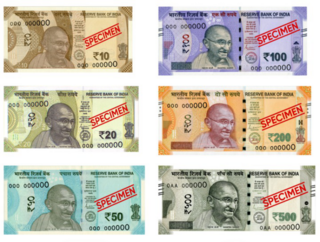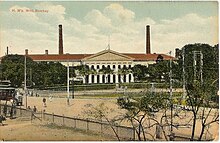
The United States Mint is a bureau of the Department of the Treasury responsible for producing coinage for the United States to conduct its trade and commerce, as well as controlling the movement of bullion. It does not produce paper money; that responsibility belongs to the Bureau of Engraving and Printing. The first United States Mint was created in Philadelphia in 1792, and soon joined by other centers, whose coins were identified by their own mint marks. There are currently four active coin-producing mints: Philadelphia, Denver, San Francisco, and West Point.

The Royal Canadian Mint is the mint of Canada and a Crown corporation, operating under the Royal Canadian Mint Act. The shares of the Mint are held in trust for the Crown in right of Canada.

The Indian rupee is the official currency in the Republic of India. The rupee is subdivided into 100 paise. The issuance of the currency is controlled by the Reserve Bank of India. The Reserve Bank manages currency in India and derives its role in currency management on the basis of the Reserve Bank of India Act, 1934.
Coins of the Indian rupee (INR) were first minted in 1950. New coins have been produced annually since then and they make up a valuable aspect of the Indian currency system. Today, circulating coins exist in denominations of One Rupee, Two Rupees, Five Rupees, Ten Rupees and Twenty Rupees. All of these are produced by four mints located across India, in Kolkata, Mumbai, Hyderabad, Noida.

The India Government Mint, Mumbai is one of the four mints in India and is in the city of Mumbai. The mint was established in 1829 by the then governor of the Bombay Presidency. Its main activity is the production of commemorative and development-oriented coins. The mint is opposite the Reserve Bank of India in the Fort area of South Mumbai.

The history of the rupee traces back to ancient Indian subcontinent. The mention of rūpya by Pāṇini is seemingly the earliest reference in a text about coins. The term in Indian subcontinent was used for referring to a coin.
The coins of Canada are produced by the Royal Canadian Mint and denominated in Canadian dollars ($) and the subunit of dollars, cents (¢). An effigy of the reigning monarch always appears on the obverse of all coins. There are standard images which appear on the reverse, but there are also commemorative and numismatic issues with different images on the reverse.

The India Government Mint, Kolkata was first established in 1757, and was located in a building next to the Black Hole in the old fort – where the GPO stands today. It was called the Calcutta Mint and used to produce coins with the mint name Murshidabad.

Coinage under British governance of the Indian subcontinent can be divided into two periods: East India Company (EIC) issues, pre-1835; and Imperial issues struck under direct authority of the crown. The EIC issues can be further subdivided into two subcategories: the Presidency issues, which comprise separate Madras Presidency, Bombay Presidency, and Bengal Presidency issues; and uniform coinage for all British territories from 1835 to 1858. Imperial issues bear obverse portraits of Queen Victoria, Edward VII, George V, and George VI. No British India coins were issued during the brief reign of Edward VIII.
The Security Printing & Minting Corporation of India Ltd. (SPMCIL) is a company under the Department of Economic Affairs, which is a department under the Ministry of Finance. It is responsible for conducting printing and minting activities of the Government of India. It is under the ownership of the Ministry of Finance, Government of India. It was incorporated on 13 January 2006 with its registered office at New Delhi. It is engaged in the manufacture / production of currency and banknotes, security paper, non-judicial stamp papers, postage stamps and stationery, travel document viz., passport and visa, security certificates, cheques, bonds, warrants, special certificates with security features, security inks, circulation and commemorative coins, medallions, refining of gold, silver and assay of precious metals, etc.

The Indian 10-rupee coin is a denomination of the Indian rupee. The ₹10 coin is the second highest-denomination coin minted in India since its introduction in 2005. The present ₹10 coin in circulation is from the 2019 design. However, the previous ₹10 coins minted before 2019 are also legal tender in India. All ₹10 coins containing with and without the rupee currency sign are legal tender, as stated by the Reserve Bank of India. Along with the standard designs, there are 4 different designs for this denomination and this is used alongside the 10 rupee banknote.
The Indian paisa() (plural: paise) is a 1⁄100 (one-hundredth) subdivision of the Indian rupee. The paisa was first introduced on 1 April 1957 after decimalisation of the Indian rupee.
The India Government Mint, Noida, is one of the four mints in India; based in Noida, in the state of Uttar Pradesh, the mint started production on 1 July 1988 and is the only India Government Mint established since India became an independent country in 1947. It produced the first stainless steel coins in India and aside from producing coins for its home country, it also produces coins for other countries.
India Government Mint, Hyderabad is one of the four mints in India. Based in Cherlapally, Secunderabad in the Indian state of Telangana, the mint was originally established in 1803 AD as the Royal Mint to serve as the mint for the Nizam of Hyderabad. The mint was founded by Mir Akbar Ali Khan Sikander Jah, Asaf Jah III and was originally situated at Sultan Sahi in Moghalpura suburb of Hyderabad city. In 1950, the mint was taken over by the Government of India, and in 1997 it was shifted to its present location at Cherlapally in Secunderabad. Indian 1, 2, 5 and 10 rupee coins are produced in this mint.

The Indian Two paise, is a former denomination of the Indian Rupee. The 2 coin equals 1⁄50 of the Indian Rupee. The symbol for Paisa is.
The Indian Two naye paise, is a unit of currency equaling 2⁄100 of the Indian rupee. The symbol for paisa is p.
The Indian Three paise, is a former denomination of the Indian Rupee. The 3 coin equals 3⁄100 of the Indian Rupee. The symbol for paisa is.
The Indian five naye paise, was a unit of currency equaling 1⁄20 of the Indian rupee. The symbol for paisa is p.

The Indian 1-rupee coin (₹1) is an Indian coin worth one Indian rupee and is made up of a hundred paisas. Currently, one rupee coin is the smallest Indian coin in circulation. Since 1992, one Indian rupee coins are minted from stainless steel. Round in shape, the one rupee coins weighs 3.76 grams, has a diameter of 21.93-millimetre (0.863 in) and thickness of 1.45-millimetre (0.057

The Indian five paise, is former denomination of the Indian Rupee. The 5 coin equals 1⁄20 of the Indian Rupee. The symbol for paisa is.












